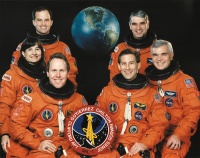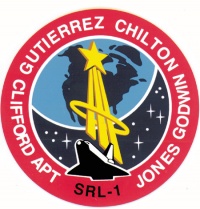STS-59
From The Space Library
 | |
| Organization | AgenziaSpazialeItaliana(Italy),BundesministeriumfuerForschungundTecnnologie(FederalRepublicofGermany),NASA-OfficeofSpaceScienceApplications(UnitedStates) |
|---|---|
| Mission type | Earth Science,Human Crew |
| Launch date | April 9, 1994 |
| Launch vehicle | Space Shuttle |
| Carrier rocket | {$Carrier Rocket} |
| Launch site | Cape Canaveral, United States |
| COSPAR ID | 1994-020A |
| Mass | {$Mass} |
| Experiments | Here |
| Alternate Names | SRL 1/STS 59,Shuttle Radar Lab 1,Space Radar Lab 1,23042 |
| Nominal Power | {$Nominal Power} |
| Additional Information | Here |
| PDMP Information | Here |
| Telecommunications Information | Here |
| Data Collection | Here |
| Payload Mass Up | 12490.0 kg |
The Space Radar Laboratory 1 (SRL 1) was the first in a series of flights of this payload which was designed to (1) acquire radar imagery of the Earth's surface for studies in geology, geography, hydrology, oceanography, agronomy, and botony; (2) gather data for future space-borne radar systems including Earth Observing System (EOS); and (3) provide measurements of the global distribution of carbon dioxide (CO2) in the troposphere. Instruments on board included the Shuttle Imaging Radar-C (SIR-C) with multi-frequency (C- and L-Bands), multi-polarization (HH, VV, HV, VH), and multi-incidence angle (15 to 55 degrees) capabilities thus lending itself to a wide range of earth surface applications; the X-band Synthetic Aperture Radar (X-SAR), an X-band, VV-polarized imaging radar system, built by Dornier (Germany) and Alenia (Italy) for the German Space Agency (DARA)/German Aerospace Research Establishment (DLR) and the Italian Space Agency (ASI); and, the Mapping Air Pollution from Space (MAPS) for the study of global air pollution. Also, on-board the SRL, was an ocean wave spectra processor, designed and built by Johns Hopkins Applied Physics Laboratory, which collected data on ocean surface wave length, direction, and height. Four 45-Mbps data channels were recorded on special high data rate tape recorders and real-time data was transmitted to ground stations. About 50 hours each of SIR-C and X-SAR data were recorded during the mission. The combined SIR-C/X-SAR Science Team was made up of 49 members and 3 associates representing 13 countries. SIR-C/X-SAR data collection was focused on several worldwide supersites and correlated with ground and aircraft measurements. Radar data was also calibrated to allow comparisons with other operating spaceborne radars (ERS-1 SAR, JERS-1 SAR).

